October 30, 2010
This year, I’ve noticed more and more pink swellings on the large coral heads in my regular snorkeling area. Wondering about the meaning of this, I sent a picture to UH coral biologist, Dr. Cindy Hunter, who confirmed my suspicion. The pink puffs are the result of a coral condition called trematodiasis, an infection by a worm parasite.
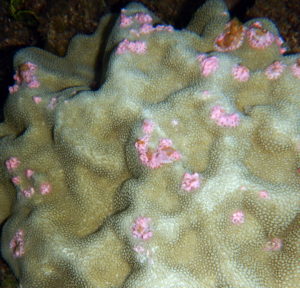
That might not be as bad as it sounds. Although a parasite is, by definition, an organism harmful to its host, trematodes on my coral heads means that three diverse groups of marine animals—fish, snails and corals—are present in good numbers, and that may be a sign of a thriving reef.
Trematodes, also called flukes, are oval-shaped worms ranging in size from barely visible to an inch or so long. All the 20,000 or so species of trematodes are parasites, living off other animals, including humans. To hang onto their hosts, trematodes have either hooks or suckers on the underside of their flat bodies.
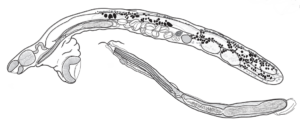
Hawaii butterflyfish flukes are visible with the naked eye, but at less than 1/10th of an inch long, just barely. Illustrations from Martin, et al, 2018, International Journal of Parasitology, 48: 1107-1126.
In the case of Hawaii’s coral trematodes, butterflyfish are one of its three hosts. Researchers found between 5 and 156 worms per fish in a study of 8 multiband butterflyfish. Adult worms suction-cup themselves inside the fish’s intestines, where the worms feed and get their eggs fertilized. Because these worms are hermaphrodites, they don’t have to search for members of the opposite sex. Each one is the opposite sex.
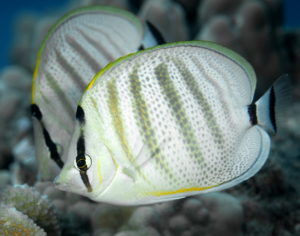
Multiband butterflyfish, common on Hawaii reefs, usually take only a few bites of a coral head and move on. The flukes have been found in other reef fish species as well. © Photo courtesy of Russell Gilbert.
When the butterflyfish defecates, the fluke’s fertile eggs wash into the ocean, and presumably get eaten by snails of unknown species. (The mollusk part of the cycle is still unclear.) Inside the snail, the flukes grow to their next stage, and when the snail defecates, the youngsters enter the ocean again as tiny swimmers searching for the common reef-building corals called Porites (Por-EYE-tees), also known as finger and lobe coral.
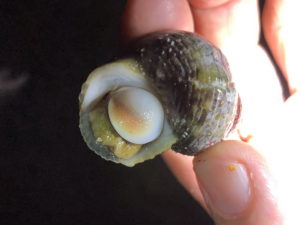
No one knows the snail species involved with Hawaii’s coral flukes, but snails are known to be intermediate hosts of these types of parasites. This endemic snail, called the Hawaiian turban snail, is common on my reef and throughout the Islands. The round white shell, called the operculum, or “cat’s eye,” is the snail’s trap door. ©Susan Scott
When it finds its target, the immature, tough-skinned fluke swims past the coral body’s circle of stinging tentacles, and nestles inside the cuplike skeleton. There it transforms into a cyst that gradually expands the coral body up and over the edges of the cup. These bulging, infected coral bodies are at first white, then pink, turn white again, and finally revert to the normal coral color, tan.
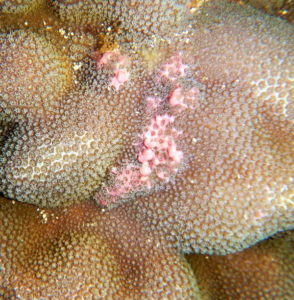
Immature flukes reside in these pink bulges, easier for butterflyfish to eat than the surrounding, uninfected coral bodies (tan.) ©Susan Scott
The pink color is the coral’s response to the invasion, its immune system producing a red fluorescent protein that shows up pink. Turning pink, though, even briefly, may not be in the coral’s best interest. To a butterflyfish, the plump pink polyps are like cotton candy. Uninfected coral bodies quickly close up and hunker down in the coral’s skeleton cup when a predator arrives. Distended polyps are far easier for the butterflyfish to bite off, and pink advertises their location.
When the coral-body-worm-cyst gets to the fish’s intestine, the worm matures, and the cycle starts again.
Because adult flukes don’t seem to harm the butterflyfish, at this stage the parasite benefits its host and vice versa, the relationship a kind of mutualism. The fish gets free pupus, and the baby worm gets a ride to the fish’s intestine. From the coral’s point of view, however, the fluke is always a parasite, causing more of its soft bodies to be eaten.
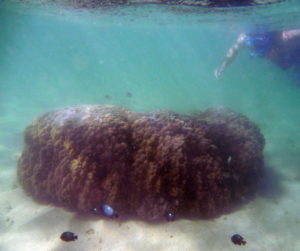
One of the Porites coral heads I visit regularly now has new pink bulges, or trematodiasis, on one side. ©Susan Scott
Researchers have recorded trematodiasis on 60% of Hawaii’s reefs. One study showed a surprising distribution. The infection occurred on only 1.1% of reefs in the main, human-impacted islands, and on 10.7% of reefs in the pristine areas of the Northwest Chain. Because this parasite requires fish, snail, and coral hosts, it’s possible that its presence means a healthier reef.
A new outbreak of parasites isn’t usually a good sign, but trematodiasis might be an exception, a least in the world of snails and butterflyfish. For corals, though, the flukes are a negative. Heavy infestations significantly slow a colony’s growth.
Now when I go snorkeling and see these bright bumps on corals , I will view them in a whole new light. As well as being food for butterflyfish, the pink puffs are also food for thought.